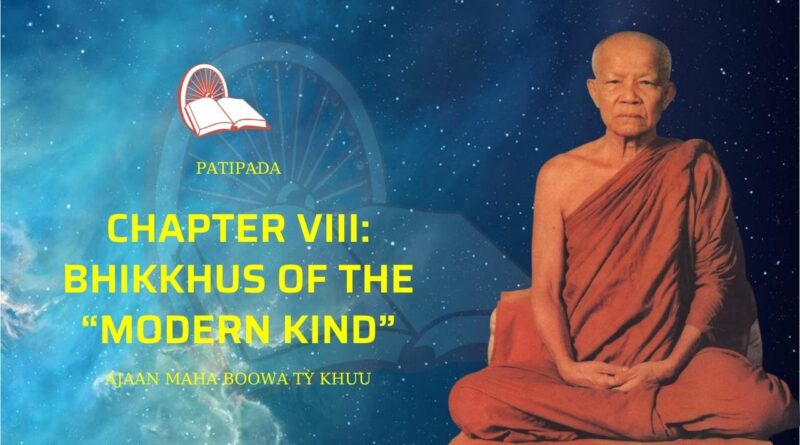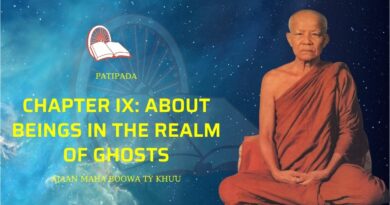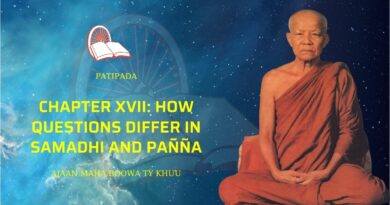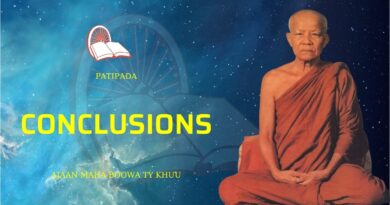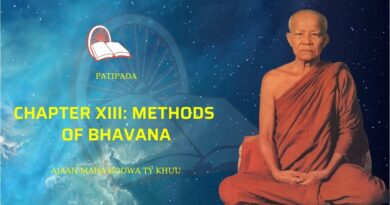PATIPADA – CHAPTER VIII: BHIKKHUS OF THE “MODERN KIND”
Generally, in the practice of the Dhutanga Kammatthana Bhikkhus who follow in the line from Venerable Acharn Mun, they like to live in the forests and hills, as we have already said before. They do this in order to get away from disturbance so as to live at ease in doing the work of a recluse (Samana–Dhamma) in their own time as they feel like it, without wasting time with other duties which are not really necessary. In particular, the Lord said that construction work and building projects are an enemy and detrimental to the work of a recluse. This is recorded in the Maha Khandhaka Vinaya, in connection with the way of development for a Bhikkhu who is just at the beginning and who has not yet gained any firm principle in his heart nor reached any level of attainment. In this, the Lord teaches that such a Bhikkhu should turn away from such works and go quickly to find a place to stay which is quiet and secluded. Thus, for instance, he should not go and stay near a boat landing place where there are often crowds of people, nor in a monastery where they are doing building or repair work. One should reflect on how, if one has a small wound it should heal quite quickly with the right treatment, but when it is left open and comes into contact with all sorts of things all the time, it will probably get worse even if one tries to protect it. The heart is like such a wound which needs to be looked after and which can get worse when it comes into contact with all sorts of things all the time.
In fact, this is true, not only for the citta which is just beginning the training, but also for one that has trained for a long time but has still not attained enough controlling principle so that he can feel some confidence — or feel absolutely confident — for there is still the possibility that he may get worse. This is like a fresh wound, or an old wound, respectively, which he does not take care of. So “taking care of”, and “looking after” are the ways of being heedful, both for those who are just beginning the training and also for those who have been training for a long time. One must not think that one is well experienced in the ways of Kammatthana and that one is adept at it just because one has done it for a long time and that one is able to go anywhere and live anywhere. To think like this is to be imprudent and careless. Or, as some would say, “imprudent to the point of being shameless”, and they are probably right. Because whether one has been training for a long time, or not, is not nearly so important as having a firmly established controlling principle in one’s heart, which is the aim of the Dhamma Teaching that has been handed down to us.
Therefore in this present age, Venerable Acharn Mun taught all his followers most emphatically about the importance of a quiet place for Dhutanga Bhikkhus of his lineage; and also how they should not become an “Acariya” teaching others before they have become an “Acariya” to teach themselves in the first place, so that the heart of each one shall have gained a firm controlling principle which is able to look after and protect himself. Then, wherever he goes he will be of no danger to himself nor harmful to others. As for being of value to others, this will follow on naturally when such a person who practises the way has a ground or basis of Dhamma which is sufficient — or which is completely fulfilled, accordingly.
To begin with one’s teaching must be to oneself — almost as if one does not let oneself look at anyone else, but only at the right and wrong, and good and evil of oneself, as well as teaching oneself to be cautious of things which harm the citta in indirect ways. This means all those things which make trouble and difficulties or which cause worry to oneself because of having to organise this or build that, for this is the kind of work that people in the world do everyday. This is not the kind of work that should be important for Dhutanga Bhikkhus whose aim is that of attaining freedom while they are still at the stage of “walking on” and teaching themselves. For their interest should be in bhavana so as to look at their own kilesas (defilements) and to see the conceit and self-opinion that they have. Rather than going about increasing their worldly ways by looking for gross burdensome pursuits to take up and get involved in, until they become a “narcotic drug” in the heart. Then one cannot live in peace but must always be arranging this or building that, otherwise the kilesas cause one trouble. Which means that one has to exercise them in doing this business or that job, sufficient to act as an object of attention and interest which it can depend on for the time being. Having finished they again cause trouble, until once again one must exercise them and this goes on all the time without ever reaching any satisfactory solution.
At first one thinks of doing such work to overcome one’s restless irritability and that one cannot live without doing such works. But in the end these works become increasingly burdensome until they actually tend to make the irritability worse. They become things which disturb both oneself and others, causing turbulence in all, like mud stirred up in water. Because those who practise the way have taken up this path to cure their kilesas and to attain calm and happiness both for themselves and other people everywhere. Therefore, so that the kilesas can gain heart they like to make their owners take them out and exercise them in the foregoing way until there is no time to rest and relax and get into a state of calm at all; and they like it even better if those who practise the way come to have no routine practices left which are regularly done as a basic discipline.
When Venerable Acharn Mun was emphatically teaching Dhamma in a manner which went to the heart, he was very afraid that it would not reach the hearts of we who were listening and who were inclined to go in the opposite direction to him. This he pointed out in ways such as:
“If any of you who practise the way want to surpass the teaching of this foolish old man, then go and do so. When you have attained the highest Dhamma using your methods, then please come and help this old man so that he can see the sky and the earth with you, for this old man just dwells in the forest practising meditation by closing his ears and eyes without looking at the moon, the stars and the world of samsara to see how it is developing and deteriorating. Anyone who wants development and progress in the modern way must use modern ways. But this old Bhikkhu has not yet got the wisdom to find out how to use these modern ways, and so he holds on to the methods of using the old Dhutanga practices which the Lord Buddha gave us, to be used according to the needs of each person. But others always want to come and be a nuisance, disturbing him all the time and not allowing him to relax even for a short time. And when they come, instead of using whatever mindfulness and wisdom they have to keep a close watch on the routine methods of practice and taking them up as their way to develop, they turn about and become modern Bhikkhus taking a short cut to get rid of their kilesas by indulging in business and works of various kinds so as to show off to the world that: ‘I have ability and talents.’ But are they talents (vasana)? In fact they seem to be nothing but kilesas which bind and tangle them up until they cannot find any time to live in peace and happiness, not even for brief periods. All they have is emotionally bound involvements (arammana) which drag them this way and that until they cannot sit still. Are these the talents of a practising Bhikkhu? I’m foolish and I don’t know what kinds of talents these are, nor how those talents should be promoted so that they may be the right way for a Bhikkhu who practises. And how then does the work of a Bhikkhu who practises with the highest aim and ideal of attaining salvation differ from other work as done elsewhere in the world? And why do they like all the troublesome involvement in the world, yet do not see what it’s all about. As for myself, I am still alive and I can see the way it has gone already, and how will it be when I am dead? Even though I am very foolish and ignorant, I know what will happen and how it is going to be from the way things are happening now in the field of those who practise.”
In addition, these Bhikkhus, once they go away from here, they wander about boasting to the world that they are followers of Venerable Acharn Mun — followers of Venerable Acharn Mun who never have time to shut their mouths, until other people are tired of hearing them; and it is significant that Venerable Acharn Mun is a forest Bhikkhu, whereas most of his followers are Bhikkhus of the modern type. This is where it will decay and decompose until it loses all form due to the boastfulness and ‘sales talk’ of Acharn Mun’s followers. This is why I am concerned about my Bhikkhus who act and behave in ways that are unusual and abnormal, setting up their teacher like food for sale in front of a shop. To begin with, this leads people to the false belief that these Bhikkhus are the Acariya’s followers, without understanding that they are the type of followers who are parasites and who, in an occult way, ‘suck his blood’, as well as that of other people in general. Secondly, it makes people tired and fed up with hearing their self-advertisements, boasting of all the things they have done, and fed up with the endless trouble and nuisance which they become in all sorts of ways. All of this is what leads to their own destruction, as well as to the destruction of their Acariya, the circle of those who practise the way and Buddhism, causing it to become lost with everything else. A vision (nimitta) which I saw in my meditation practice, of Bhikkhus running about back and forth in front of me and behind me, which is to be interpreted as showing the shameless arrogance of those practising Bhikkhus who are lacking in moral shame and moral fear (Hiri–Ottappa–Dhamma) in their hearts, is now coming into being for me to see quite clearly all the time — even while I am still alive. After I am dead, whoever has the ‘stripes of the tiger’ or the ‘spots of the leopard’ concealed within them are then bound to display them as much as they can. For they have already begun to sell themselves and their teacher to some extent, in various ways which depend on the colour of their ‘stripes or spots’. This is an indication which can be clearly seen in the present, of the harm which they will do in the future.”
He further emphasised this theme, saying: “If there is anyone here at present who wants to be clever and bold-faced in a shameless way even while still staying with me, please say so! I will set you up as the ‘great teacher’ of the way of practice right now — even though you are still full of stupidity. But I want to let the others admire you as a thoroughly clever person to satisfy your desire, so you must speak out now! A skilled and clever person is rarely found and I would like to meet one, for I would be sorry to die without having this opportunity. Therefore I want to meet you now, while I am still alive.”
This is how Venerable Acharn Mun could be truly forceful, strong and acerbic when he wanted to be and those who heard it would sweat profusely as they felt hotter than fire. But for those who listened with interest in learning the way of Dhamma and who were truly intent on the way of practice, the more forceful it was, the more their hearts submitted to it, the more they accepted it and the more cool they felt. This was very different from those times when he taught Dhamma in the usual way.
The foregoing was written so that the reader may get an idea of what Venerable Acharn Mun was like, both when he was benign, when he was acerbic and in various other aspects of his character, as well as that of his followers. Some people may think that his followers were all good, like their teacher, but in truth they are mixed, some good and some bad, like parents may have many children, some good and some bad mixed together. The followers of Venerable Acharn Mun had kilesas, so there may well be that which is good, unavoidably mixed up with that which is blameworthy. To look and examine well in all situations both externally and internally and to act accordingly is the right way of being circumspect in Dhamma. It is also a boon and blessing to that person in particular, and afterwards to others who accept what he says.
Some things which Venerable Acharn Mun taught exclusively to the circle of those who practise, and special aspects of Dhamma which he taught in a forceful, provocative manner, are not suitable for inclusion in this book. But I have the bad and perverse tendency to like those talks which are more forceful and provocative than usual, because they go straight to the heart, which dwells deep down and does not like to rise to the surface to show itself nor to accept the Dhamma teaching easily. But when the heart does rise to the surface to accept Dhamma, even though it may be forceful and provocative, it is prepared to put up with it. Therefore, a sample of this kind of talk was included above for those readers who have similar temperaments to the writer, and who may be aroused by it to think in ways that will be of some value to them. If however the reader feels that it was inappropriate then I ask for your forgiveness. But normally, Dhamma has many facets and it may be profound or simple, and gross or subtle. So the teaching of Dhamma should be of various types to correspond with the different facets of Dhamma, so that those who receive it and who have various different characters may choose the type that fits them best. What is written in this book has also been done with this same principle in mind so that the reader may choose what he likes to bring him some benefit. As for me, I am doing the best I can to assure that all who read this book shall gain something of value from it.

